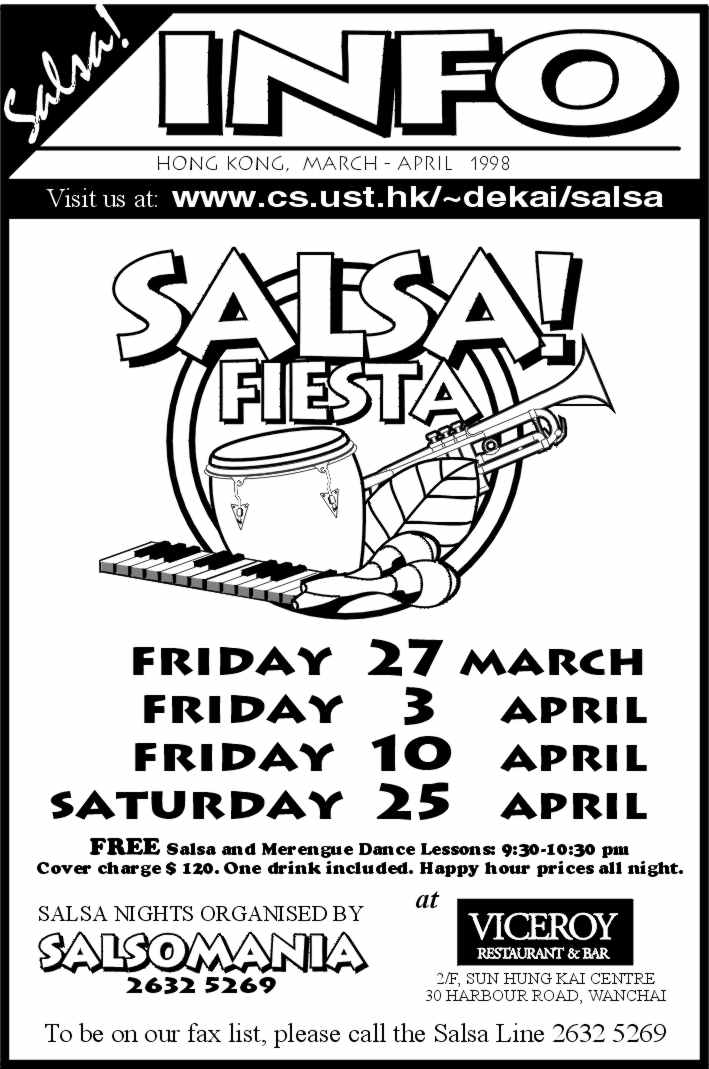
|
| Description |
| |
Salsa is the
main theme. More than half of the music played is salsa of all varieties:
salsa of the early years - mostly Fania-all-stars musicians, the New York
era of the 60s and 70s. Then there is the salsa of the 80s, the erotic
salsa and the romantic salsa of the 90s, the Cuban salsa, and salsa from
Japan and from West Africa. About 20% of the music played is merengue,
originally from the Dominican Republic, a cheerful and easy music to dance
to. Then come Colombian music, Cumbia and Vallenato. From Brazil we have
Samba, Forro and Lambada. There is an occasional old time mambo and cha-cha-cha,
or a slow, romantic bolero or a bachata from the Dominican Republic. Also
every now and then there is kizomba from Angola, morna from Cap Vert or
even rai from Algeria. For the Spanish dancers, there may be a Spanish
rumba and inevitably some Sevillanas.
|
| Salsa
Sabrosa! One
Year in Hong Kong by
Tess Mora |
| |
Yes! It's been one year
now since the Salsa nights began at the Viceroy in Wanchai. In retrospect
what are the memories that stand out over the past year? Granted we could
mention the high attendances, the regular Salsa dance classes, the increase
from one Salsa night a month to once a week, but the real question is:
What is the X factor that attracts so many people to the Salsa dance parties?
As a regular, my impressions
over the past year include the following:
-
An uncompromising attitude toward
good music: Salsa, merengue, cumbia, African rhythms, it's the real thing,
no Barry Manilow fill-ins!
-
A genuine sense of enjoyment,
of the music, of watching people around you discover the sensual and passionate
nature of Salsa, or really getting involved. Too often you can go to a
nightspot and spend heaps of money and at the end of the night you get
nothing out of it except to say that you were seen there!
-
Surprises happen! Over the past
year the Salsa parties have been visited by a belly dancer, a troupe of
Mexican mariachis, a Scottish samba drum group, the Gypsy Kings and many
other musicians that are attracted to the unique atmosphere of these parties.
-
You get to meet people, share
your stumbling footwork through the dance lessons given at the beginning
of the night. Going through the place meeting people spontaneously, I've
met Colombian navy officers in their shining white uniforms, African refugees,
businessmen, artists, musicians and many others.
-
Last but not least, when it
gets too hot dancing you can go out onto the terrace and breathe in the
night breeze and spectacular views of Hong Kong.
I say VIVA SALSA! and I look
forward to the second year of Salsa.
|
| One
Year of Salsa in the Making |
| |
At the end of 1996 when
Bo returned to Hong Kong after living some 20 years abroad, there was hardly
any trace of Salsa in this cultural desert. Few persons here have ever
heard of the word Salsa. As a true salsero, he decided to make it happen
himself. After some searches he managed to gathered a small group of learners
and-fortunately enough-also several native salseros and other passionate
salseros like himself. Thus in February 1997 he organised what is believed
to be the first ever major Salsa party in Hong Kong, at the Bar Latino(
no longer existing as such ) in Tsim Sha Tsui. The turn-out
surprised everyone: some 200 people came and enjoyed themselves to the
fullest. Bo then formed a Salsa team, and after more tedious searches,
he found a better venue at a better location; the Viceroy.
On the 21st March 1997 the first Salsa night there saw about 100 persons
attending; the Salsa team had only 3 days to notify everybody. The second
Salsa night at the Viceroy, almost one month later, on a Thursday night,
saw the attendance doubled. Two weeks later, again on a Thursday night,
we had 350 persons. The fourth was on a Friday and 500 persons poured in
together with a downpour. The fifth party had 600! With time the novelty
factor subsided, many clubbers returned to their mainstream dance scenes,
but Salsa managed to maintain high attendances even during holiday periods,
and more importantly, Salsa always managed to maintain that spontaneity,
that passion and that wild and profane joyful atmosphere. In time Salsa
drew more and more persons from every corner on earth who really identify
themselves with the spirit of Salsa. Afro-Cuban music brings people together
and make them treat each others as equals. And thus, between parties and
parties, an informal community is born.
The Salsa group's main aims
in the past year have been to establish and to consolidate an awareness
for authentic, not pseudo, Afro-Cuban music and dance here in Hong Kong.
To this aim, low-cost but highly effective Salsa and merengue dance courses
were given to more than a thousand persons in the past year. While continuing
to offer these courses and workshop and to ever improve our Salsa nights
at the Viceroy, the coming year we have still bigger dreams and objectives.
We aim at bringing top quality live Salsa music to Hong Kong and to try
to form a local Salsa band as well. It'll no doubt be a very, very hot
year! Imitation is the most sincere form of flattery and actually
we are very pleased by the news of quite a number of people and venues
trying to catch onto the "craze" and to get a share in what they probably
think is the new gold mine. They will copy the format, use the name of
the music, yet they will never be able to copy the spirit of Salsa. They
do not have passion, the heart. And where there is no passion, there is
no Salsa. |
